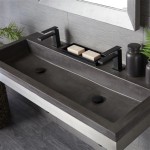Kohler Bathroom Sink Faucet Aerator Replacement: A Comprehensive Guide
The Kohler bathroom sink faucet is a popular choice for many homeowners due to its design, durability, and functional performance. A crucial component of any faucet is the aerator, a small mesh screen device that mixes air with water, creating a smoother, non-splashing stream. Over time, aerators can become clogged with mineral deposits and debris, leading to reduced water flow and diminished faucet performance. Replacing a Kohler bathroom sink faucet aerator is a simple and cost-effective way to restore the faucet to its optimal condition and conserve water. This guide provides a detailed explanation of the process, including identifying the aerator type, gathering necessary tools, removing the old aerator, and installing the new one.
Kohler faucets utilize various aerator designs, each requiring a slightly different approach for removal and replacement. Understanding the specific type of aerator installed in the faucet is the first step in a successful replacement process. Aerators can be broadly categorized into standard aerators, hidden aerators, and specialty aerators with unique locking mechanisms.
Identifying the Kohler Faucet Aerator Type
The first step in replacing a Kohler bathroom sink faucet aerator is to accurately identify the type currently installed. This is crucial because different aerator types require slightly different tools and techniques for removal. A careful visual inspection is generally sufficient to determine the aerator type. The most common types encountered in Kohler faucets include the standard aerator, the hidden aerator, and occasionally, specialty aerators designed with proprietary locking mechanisms.
A standard aerator is typically visible and protrudes slightly from the faucet spout. It often has small flat sides or slots that can be used to grip it with pliers or an adjustable wrench. The design is straightforward and generally easy to access. These aerators are frequently found in older Kohler faucet models or in more basic faucet designs.
A hidden aerator, as the name suggests, is designed to be less visible and more integrated into the faucet spout's overall design. These aerators are typically recessed within the spout and require a specialized aerator key or tool for removal. The spout may appear smooth and seamless, with no obvious way to remove the aerator without the correct tool. Hidden aerators are prevalent in more modern and aesthetically driven Kohler faucet designs, contributing to a cleaner, more streamlined look.
Specialty aerators are less common but may be present in some Kohler faucet models. These aerators may feature unique locking mechanisms or require specific tools sold by Kohler for removal. Documentation accompanying the faucet or the Kohler website may offer specific information on the presence of a specialty aerator and its removal procedure.
Once the aerator type is identified, the appropriate tools can be gathered, and the removal process can begin.
Gathering the Necessary Tools and Materials
Having the correct tools and materials readily available ensures a smooth and efficient aerator replacement. The required tools typically include an aerator key (if applicable), an adjustable wrench or pliers (preferably with the jaws wrapped in tape to prevent scratching the faucet finish), a small container to catch any water or debris, a soft cloth or towel, and, most importantly, the correct replacement aerator compatible with the specific Kohler faucet model. Thread seal tape may also be useful, although it's not always necessary.
An aerator key is specifically designed to remove hidden aerators. These keys come in various sizes and shapes, so ensuring the correct key is selected for the Kohler faucet model is vital. Many hardware stores and online retailers offer aerator key sets that include multiple sizes to accommodate a range of faucet brands and models. Using the wrong size key can damage the aerator or the faucet spout.
An adjustable wrench or pliers can be used to remove standard aerators. Protecting the faucet finish is essential when using these tools. Wrapping the jaws of the wrench or pliers with tape (such as Teflon tape or electrical tape) will help prevent scratches and marks on the faucet's surface. Apply gentle pressure when turning the aerator, as excessive force can damage the threads.
A small container, such as a cup or bowl, should be placed under the faucet spout to catch any water or debris that may be released when the aerator is removed. This helps prevent water from splashing onto the countertop or floor.
A soft cloth or towel is useful for cleaning the faucet spout and the surrounding area. It can also be used to wipe up any spills or drips that may occur during the replacement process.
The most crucial material is the correct replacement aerator. To ensure compatibility, consult the Kohler faucet's documentation or the Kohler website to identify the specific aerator model number. Alternatively, the old aerator can be taken to a hardware store to find a matching replacement. Using an incorrect aerator can result in leaks or improper water flow.
Thread seal tape, also known as Teflon tape, may be used to create a watertight seal between the aerator and the faucet spout. This is generally not necessary if the replacement aerator comes with a rubber O-ring, but it can be helpful if the fit is loose or if leaks are observed after installation.
Removing the Old Aerator and Installing the New One
Once the aerator type has been identified and the necessary tools have been gathered, the physical removal and installation process can proceed. It is generally recommended to shut off the water supply to the faucet before beginning this procedure. This step will help to prevent any unexpected water flow that could create a mess or damage surrounding areas. The shut-off valves are typically located under the sink, connected to the hot and cold water supply lines. Turn both valves clockwise until they are fully closed.
For standard aerators, use an adjustable wrench or pliers to gently turn the aerator counterclockwise. The goal is to loosen the aerator without applying excessive force. If the aerator is stuck, try applying a penetrating oil or lubricant to the threads and allowing it to sit for a few minutes before attempting to loosen it again. Once the aerator is loose, it can be unscrewed by hand. Carefully remove the aerator from the faucet spout.
For hidden aerators, the process is slightly different. Insert the correct size aerator key into the slots on the aerator. Apply gentle pressure while turning the key counterclockwise. The aerator should begin to loosen. Continue turning until the aerator is completely unscrewed from the faucet spout. Remove the aerator and the aerator key.
After the old aerator has been removed, inspect the faucet spout for any mineral deposits or debris. Use a soft cloth or brush to clean the threads and the interior of the spout. This will ensure a clean and secure fit for the new aerator.
Before installing the new aerator, examine it for any damage or defects. Ensure that all the components, such as the screens and rubber O-rings, are in place. If the new aerator comes with thread seal tape, wrap a few layers of tape around the threads of the aerator in a clockwise direction. This will help create a watertight seal.
To install a standard aerator, align the threads of the aerator with the threads inside the faucet spout. Screw the aerator in by hand until it is snug. Then, use an adjustable wrench or pliers to tighten it further, but be careful not to overtighten, as this could damage the aerator or the faucet spout.
To install a hidden aerator, insert the new aerator into the faucet spout. Use the aerator key to gently turn the aerator clockwise until it is snug. Avoid overtightening to prevent damage.
After the new aerator has been installed, turn the water supply back on by turning the shut-off valves counterclockwise. Check for any leaks around the aerator. If leaks are present, try tightening the aerator slightly. If the leaks persist, remove the aerator and inspect the threads for any damage or debris. Reapply thread seal tape if necessary and reinstall the aerator.
Once the faucet is leak-free, test the water flow. The new aerator should provide a smooth, non-splashing stream of water. If the water flow is still restricted, the aerator may be clogged with debris. Remove the aerator and clean it thoroughly before reinstalling it.
Proper aerator maintenance involves periodic cleaning to prevent mineral buildup and ensure optimal performance. The frequency of cleaning depends on the water quality and the amount of usage the faucet receives. In areas with hard water, more frequent cleaning may be necessary. Cleaning can be accomplished by soaking the aerator in a solution of vinegar and water. Disassembling the aerator components and scrubbing with a soft brush can also remove stubborn deposits.

How To Remove And Clean A Faucet Aerator Kohler Removal

Kohler Faucet Aerators High Quality Replacements Aerator Com

Low Flow Faucet Aerator

Kohler Faucet Aerators High Quality Replacements Aerator Com

Kohler Pull Down Kitchen Faucet Aerator Change For Free

Kohler Faucet Aerators At Com

Kohler 1031237 Cp Aerator Assembly For Forte K 10443 Faucet

Kohler 1 5 Gpm Aerator Kit In Bright Chrome 1108235 Bc The Home Depot

Kohler Standard Aerator At Com

How To Replace A Sink Aerator
Related Posts







